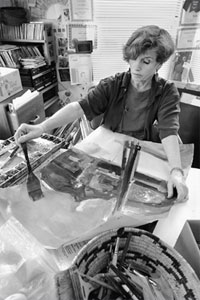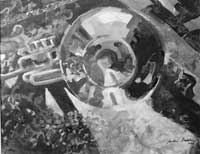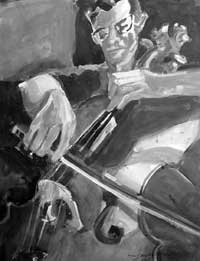By Martin Stillion Photos by Jimi Lott ![]() Brooks is often in her Queen Anne studio for six to eight hours a day.
Brooks is often in her Queen Anne studio for six to eight hours a day.![]() "Horn on Oriental Carpet" was created when Brooks placed a French horntogether with the vibrant red Oriental carpet that covers her living roomfloor.
"Horn on Oriental Carpet" was created when Brooks placed a French horntogether with the vibrant red Oriental carpet that covers her living roomfloor.![]() A Russian cellist at Augustana College became the subject of "CelloProfessor."
A Russian cellist at Augustana College became the subject of "CelloProfessor."

Before you answer that question, consider the paintings of Seattle PacificUniversity alumna Jackie Brooks '57. Musical images — instruments,players, even sheet music — fill Brooks' artwork, just as they'vefilled her life. "A number of people look at my paintings and say theyactually hear music," she says. "A psychoanalyst said he could hear theDvorak cello concerto." Born in South Dakota, Brooks grew up in Longview, Washington, in the 1940s.She took piano lessons as a child until her mother sold a small farm she'dinherited and bought a violin for Jackie and a cello for her sister,Virginia. Brooks began studying the violin in the fifth grade. But she alsowanted to paint — and when she was a sophomore in high school, Brooksrecalls, "an art teacher whose forte was watercolor took a special interestin me. ... I learned looseness and a lot of color, and not always paintingexactly what you see." She enrolled at Seattle Pacific College in the mid-1950s, when the schoolhad no degree program, and only a smattering of courses, in the visual arts.So she pursued her other great interest: a degree in music education. Shewent on to teach both art and music, perform with the Cascade Symphony,marry fellow alumnus David Brooks '58, and raise two sons. (Jeff '83 is theprincipal bassist in Thalia Symphony, SPU's orchestra-in-residence, and asenior writer at The Domain Group, a Seattle advertising agency. Brooks'other son, Arthur, played the French horn and now teaches economics atGeorgia State University.) And she kept on painting. At last count, Brooks had been accepted into more than 70 such competitions,and she took home awards from half of them. A member of seven watercolorsocieties, she's recently shown her work in New York, Montana, Texas,Oklahoma, Washington and Arizona. SPU's Art Center Gallery showed several ofher pieces at Homecoming 2001, and she's traveled as far as Nicosia, Cyprus,to display paintings and conduct workshops. Ten years ago, as a result of Parkinson's disease, Brooks had to put herviolin aside. She no longer had the fine motor control necessary to play theinstrument in an orchestra, although with medication she could still use apaintbrush. But, she says, a new sense of urgency infused her work: "I thought, 'I don't have time to do conventional paintings any more. I needto express what I really feel inside.' Some of it was anger; some waselation." And as a Christian, she felt the need to be honest about herexperience. So she developed a bold, assertive style characterized byintense colors and strong emotions, and she chose to focus on subjects thatheld deep personal relevance for her. That meant lots of music paintings and family portraits, which cover thewalls of her Queen Anne home studio: her son Jeff immersed in the sound ofhis string bass; her granddaughter Emma trying on one of Brooks' own hats;her husband in the foreground of a Cyprian landscape. Though the topics arepersonal, there's plenty in Brooks' work for others to appreciate. One ofher biggest fans, Seattle violin dealer Rafael Carrabba, displays several ofher paintings in his shop, and even sells postcard prints of them. Sometimes she'll transform an old work by painting a new one on top of it,and there's always more than meets the eye: A row of organ pipes servedouble duty as champagne flutes. A tiger morphs into a French horn. Shadowyforms inhabit the panes of a stained glass window — possibly, Brookssuggests, they're reflections of the artisans who built the church. Brooks believes her unconventional approach has helped her make the leapfrom pretty paintings to beautiful ones: "People who don't know much aboutart will often say,'Oh, how pretty.' Beauty goes beyond pretty because itmoves into the soul of the painter, and it brings out a knowledge thatsometimes you don't even know is there." Perhaps, then, her own dictum — "not always painting exactly what yousee" — doesn't quite do her work justice. You could say that Brooksdoes paint what she sees; it's just that she's learned to look at things alittle differently. Editor's Note: To view 40 of Jackie Brooks' paintings in color,  Heard any good watercolors lately?
Heard any good watercolors lately? Eventually her husband, David, returnedto Seattle Pacific to teach mathematics. The school's art program had grownin the meantime, and Brooks herself came back to earn a visual arts degreeand subsequently to teach watercolor techniques. "She's not someone who justsits in her house and paints," says SPU Professor of Art Larry Metcalf. "Shegets out and tries to find shows, and works on national competitions."
Eventually her husband, David, returnedto Seattle Pacific to teach mathematics. The school's art program had grownin the meantime, and Brooks herself came back to earn a visual arts degreeand subsequently to teach watercolor techniques. "She's not someone who justsits in her house and paints," says SPU Professor of Art Larry Metcalf. "Shegets out and tries to find shows, and works on national competitions."  Brooks' style is hard to peg —it's a carefree blend of expressionism and realism, neither completelyabstract nor fully representational. "I would say that it is quiteexperimental, and it is emotional, and usually too big to be in anybody'shouse," she says. "I would really like to get into having my paintings hungin public places where there's a lot of space."
Brooks' style is hard to peg —it's a carefree blend of expressionism and realism, neither completelyabstract nor fully representational. "I would say that it is quiteexperimental, and it is emotional, and usually too big to be in anybody'shouse," she says. "I would really like to get into having my paintings hungin public places where there's a lot of space."
![]()

| Pleaseread our disclaimer.Send any questions, comments or correspondence about Response tojgilnett@spu.edu or call 206-281-2051. Copyright © 2001 University Communications, Seattle Pacific University. Seattle Pacific University |